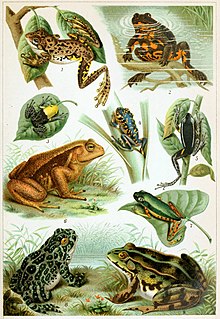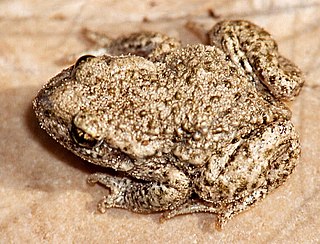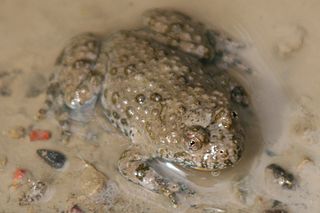
A frog is any member of a diverse and largely carnivorous group of short-bodied, tailless amphibians composing the order Anura. The oldest fossil "proto-frog" Triadobatrachus is known from the Early Triassic of Madagascar, but molecular clock dating suggests their split from other amphibians may extend further back to the Permian, 265 million years ago. Frogs are widely distributed, ranging from the tropics to subarctic regions, but the greatest concentration of species diversity is in tropical rainforest. Frogs account for around 88% of extant amphibian species. They are also one of the five most diverse vertebrate orders. Warty frog species tend to be called toads, but the distinction between frogs and toads is informal, not from taxonomy or evolutionary history.

Toad is a common name for certain frogs, especially of the family Bufonidae, that are characterized by dry, leathery skin, short legs, and large bumps covering the parotoid glands.

Bombinatoridae is a family of toads found in Eurasia. Species of the family have flattened bodies and some are highly toxic.

The Alytidae are a family of primitive frogs. Their common name is painted frogs or midwife toads. Most are endemic to Europe, but three species occur in northwest Africa, and a species formerly thought to be extinct is found in Israel.

The European fire-bellied toad is a species of fire-bellied toad native to eastern parts of mainland Europe, where it can be found near waterbodies such as ponds and marshes. It is known for its red colored belly used to ward off predators, an example of aposematism, and its distinctive "whoop" call.

The yellow-bellied toad belongs to the order Anura, the archaeobatrachial family Bombinatoridae, and the genus of fire-bellied toads. The toad is distributed mainly across western Europe as well as a handful of countries in eastern Europe. While the population of the toad is steadily decreasing over time, its numbers are not critical enough to be considered threatened or extinct. Conservation efforts in Germany are taking place to remedy the declining population before it is too late.

The Oriental fire-bellied toad is a small semiaquatic frog species found in northeastern Asia, where they primarily dwell in slow-moving bodies of water and temperate forests. Quite common throughout much of their range, these frogs have mild toxins that can be excreted through their skin, with their vibrant underbellies serving as a warning of this. While not a true toad, their green and black skin is covered in small tubercles, giving them a toadlike appearance. Their sounds, mainly produced by males during the mating season, are very unlike those of other frogs. While their population is in decline, their numbers are still high overall, with the International Union for Conservation of Nature (IUCN) rating them as a least-concern species. They are commonly kept as pets in land and water vivaria, as a relatively easy-to-care for species. They are also frequently used in scientific research, with their behavior, vocalizations, and learning skills all moderately studied.

Barbourula busuangensis is a species of frog in the family Bombinatoridae. It is also known under the common names Philippine flat-headed frog, Palawan flat-headed frog, Busuanga jungle toad, Busuanga disk-tongued toad, and Philippine aquatic frog. It is endemic to the Busuanga, Culion, Balabac, and Palawan islands in the Philippines. It is an inhabitant of clear-water streams and is threatened by habitat loss.

The Bornean flat-headed frog is a species of frog in the family Bombinatoridae. Although many salamanders are lungless, the Bornean flat-headed frog is the first frog known to have no lungs.
Bombina maxima, commonly known as the Yunnan firebelly toad or large-webbed bell toad, is a species of toad in the family Bombinatoridae found in Yunnan, China and likely to Myanmar. Its natural habitats include swamps, springs, marshes, arable land, canals, and ditches. Although easy to care for, handling a large-webbed toad should be kept to a minimum because their skin secretes a toxin that can cause irritation
Bombina microdeladigitora is a species of toad in the family Bombinatoridae endemic to Guangxi, Hubei and Sichuan in China. It is commonly known by several names including Guangxi firebelly toad, Hubei firebelly toad, large-spined bell toad, Lichuan bell toad, small-webbed bell toad, and Yunnan firebelly toad. Its natural habitats are subtropical or tropical moist montane forests, temperate forests, rivers, swamps, and freshwater marshes. It is threatened by habitat loss.
Djoko Tjahjono Iskandar is an Indonesian herpetologist who studies the amphibians of Southeast Asia and Australasia. He is a professor of biosystematics and ecology at Bandung Institute of Technology in West Java, Indonesia.
Hatzegobatrachus is an extinct genus of prehistoric toad. It is sometimes considered the earliest known member of the family Bombinatoridae. It is known from the Late Cretaceous Densuş-Ciula Formation and Sard Formation of Romania, in the region that was once Hateg Island.
Eobarbourula delfinoi is an extinct toad which existed in what is now Gujarat, India, during the Middle Ypresian age of the early Eocene. It was described by Annelise Folie, Rajendra S. Rana, Kenneth D. Rose, Ashok Sahni, Kishor Kumar, Lachham Singh and Thierry Smith in 2012, and is the only species in the genus Eobarbourula. The name of the genus is a combination of "Eo", referring to the epoch in which the animal existed, and Barbourula, the generic name of the jungle toads, while the specific epithet refers to Massimo Delfino, an Italian paleontologist.

Cyclocoridae is a family of elapoid snakes endemic to the Philippines.










